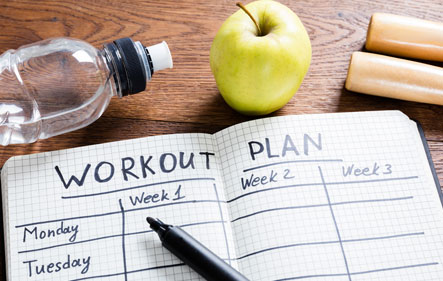Well, itís official - Summer is over. The leaves are turning and you may have even had snow depending on what part of the country youíre in. Of course here in California itís still sunny ... just a little bit cooler in the mornings. The days are a bit shorter and not quite as sweltering. But no matter where you live, for most of us the changing season means no more early morning outdoor workouts and the end of sunset hikes.
But a change in the weather can also be an opportunity to change (or start) your workout regimen. After all, you donít wear the same outfits all year long do you? Even in LA there are seasonal wardrobes - no, not just beachwear and eveningwear! Why shouldnt you have a seasonal workout plan? Itís a great way to alleviate boredom, stay motivated and focus on target areas that need some extra attention.
Like anything else, planning is the key to success. But before you start that new workout regimen, you may want to follow these five essential steps to designing your fitness plan.
- Set a Goal for Your Workout Plan
- Plan Your Motivation Methods
- Structure Your Workout Program
- Tailor Your Workout Schedule to Ensure Consistency
1 - SET YOUR GOAL

Letís start with Step 1 -- setting a workout goal. Sounds easy right? Your goal may just be to shave off a couple of inches on your waist, or to maintain your weight during the holiday season despite all the delicious meals youíll be having. If thatís your goal ... uhm, thatís not a goal. You need to be specific about your workout goal if you intend to actually achieve it. If your goal is to trim 2-inches off your waist within the next six weeks -- thatís a specific and potentially achievable goal. If your goal is to lose 10 pounds but you donít have a timeframe for hitting that target you need to get specific about a deadline for achieving that goal. Your goal must also be realistic. If your intention is to lose 30 pounds to have the body of a fitness model, unless you have a full-time personal trainer, a dietitian, plus hours of time every day to work out, youíre probably not going to achieve that goal -- at least, not in a few weeks time. To set your workout goal, you need to get real.
Getting real also means knowing how much time you can devote to achieving the task. If you work a 10-hour day and have a 2-hour commute, itís probably unrealistic to believe youíre going to be hitting the gym after work every day. That may mean achieving your goal requires at-home workouts, which are much easier to do these days thanks to the millions of YouTube videos and structured online classes that allow you to sweat from the convenience of your abode (thank you, Peloton).
Bottom line ... be smart about setting your goal. Is it realistic? Do you have the time and resources to achieve it? Is your goal measurable? Can you create a series of milestones that can help you stay on track to hit your big goal? Can you visualize your result? If you can envision your goal, you can achieve it. Starting slow and building on your success makes it more likely that youíll reach the ultimate goal. Smaller goals and firm deadlines allow you to track your progress and see incentivizing results.
Whether youíre embarking on a weight training regimen, yoga sessions or HIIT training, Step 1 is crucial to the success of your workout program.
2 Ė MAINTAIN YOUR MOTIVATION

Step 2, maintaining motivation, is just as important as goal-setting. Itís also the toughest part of any fitness program if working out is not a regular part of your lifestyle. Thatís why 4% of new gym members quit by the end of January, and 14% quit by the end of February. Yes, the toughest thing about motivation is ... maintaining motivation. So how do you beat the Workout Blues? Try these tips:
- Lay out your gym wear the evening before
- If you work out at home, make your workout space enticing
- Too tired to do your planned workout? Commit to a "mini workout" of 5-10 minutes to stay in the habit
- Put in those AirPods and start listening to your workout music
- Stand in the mirror and remember the reason you're working out in the first place
You may need to combine these motivation tips to get moving, but hey Ö whatever it takes!
3 - CREATE YOUR WORKOUT PROGRAM

Now that you have a specific fitness goal with plans in place on how to stay motivated, itís time for Step 3, Create a Workout Program. Remember, youíre switching it up from your summer workouts, or maybe youíre just starting out on your fitness journey. Whatever your circumstance, you want to construct a program that will deliver RESULTS:
Determine Your Workout Split
Maybe you're not a fitness trainer and are asking ďwhat exactly is a workout split?Ē Itís just a fancy way of saying how you'll construct your workout program. Are you doing weights one day and cardio the next? The idea is to organize your exercises and training schedule so that you manage your energy and recovery while you progress.
Choose Your Exercises, Sets and Reps
Formulate your workout strategy to build on the exercises that get results. If waist reduction is your goal, core exercises may be combined with cardio to achieve your goal. Initially, you may be starting with one or two sets until your body is ready for more.
Determine the Progression of Your Workouts
Once youíve decided on your workout split and exercises, youíll need to determine how to progress with your workouts to hit your target goal. How do you make your workouts more challenging week after week, month after month? Plan your progress to achieve your ultimate goal.
Put It All Together
Now that youíve mapped out your workout program, put it all together and get started!
If the idea of creating your workout program is a bit overwhelming, check out these tips on how to build your first workout program. The focus is more on weight training but the concepts can be applied to almost any type of fitness program.
4 - STAY CONSISTENT

Consistency is actually a product of a few key factors ó a clearly defined fitness goal, constant motivation and a realistic schedule and timeline for achieving your ultimate results. As is true with any goal, you donít go directly from A to Z. Itís the milestones along the way that ultimately get you across the finish line.
Positive results fuel consistency, and consistency helps you progress from one milestone to the next. Your progress is a success story in the making, so take advantage of a few Ďconsistency assistsí that will help you tell the tale:
- Track your progress with a fitness tracker or app to journal your improvement.
- Set a schedule and stick to it no matter how tired you may be.
- Mark your progress with weekly weigh-ins on the same date and time.
- Take a weekly ďsuccess picĒ to document your improvements.
Consistency is all about being disciplined; holding yourself accountable . And when it comes to maintaining fitness, its really no different from brushing your teeth or bathing daily. Itís basic health and hygiene. Remember, if you donít make time to stay healthy now, eventually youíll be FORCED to make time for your illnesses. Can you say root canal?
5 -- REWARD YOURSELF!

The key to rewarding yourself for your workouts is to not confuse Ďrewardí with Ďgluttonyí. Achieving a workout milestone is not an excuse to gorge yourself with a deep dish meat-and-cheese pizza. (stop salivating!)
Make your rewards proportionate to the milestone. Doing your daily workout could entitle you to that extra cup of popcorn Ė an additional 120 calories, but hey, you burned 400 doing your workout! Achieving that milestone of reducing your waistline by an inch might earn you a shrimp cocktail appetizer and a glass of wine. And when you've finally achieved your ultimate goal? Maybe THEN youíve earned a delicious pizza Ė a thin crust veggie one (and go easy on the cheese).
Of course, your rewards donít have to revolve around food. You could treat yourself to a spa day, or buy that outfit youíve been wanting, or Ö okay, who am I kidding. Itís going to be food!
Whatever your reward may be, remember you need a reason for the reward. So go earn it. Get off your butt and start working on that Fall/Winter Workout Plan!

END



